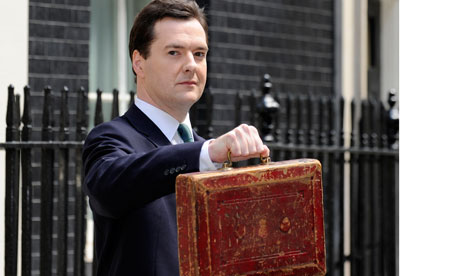George Chapman challenges George Osborne
 |
| image from: static.guim.co.uk |
In principle, the remedy for our limping economy is simple. It is imperative that we cut the deficit (as much as we can) whilst stimulating growth at a sustainable level. However, the policies required for such macroeconomic engineering are not so easy to uncover, and unfortunately George Osborne is probably not our Sherlock Holmes.
The deficit hawk’s recent austerity measures were (and indeed still are) what this economy needs to begin to cut the UK UK
As any point on the aggregate demand curve represents GDP, we can diagrammatically appreciate this economic shrinkage through the shift of curve AD1 to AD2 and the intersection of the shifted aggregate demand curve with short run aggregate supply. The economy has reached a new equilibrium, where a fall in inflation and deficit reduction has occurred but where the economy is also feeling the effects of both austerity measures and unemployment. In short, although this policy can be employed to remedy the deficit, it should not be used exclusively in order to be of optimal benefit to the UK UK
Free-marketers would argue we need to spend or invest our way out of a recession, and boost growth as much as the economy will allow. Industry deregulation and corporation tax cuts in accordance with a reduction in government spending as above will encourage private sector investment I. Thinking back to the summation AD = C + I + G+ (X-M), an increase in investment I will hypothetically have an inverse effect to above, and there will be an expansion of the aggregate demand curve. Thus, the result is GDP, and colloquially economic, growth.
To summarise, when posed with two different macroeconomic problems, it is not possible to combat both with one individual policy. With the UK
See Mr Jordan's original challenge:

Comments
Post a Comment
Comments with names are more likely to be published.